
(Credit: Pixabay)
Future heart surgeries will be better informed, as cardiologists will have access to detailed information regarding the 3D disposition of the human conduction system, which is responsible for generating the heartbeat.
This is how Robert Stephenson from Aarhus University/Aarhus University Hospital summarizes the clinical and research implications of the new 3D imaging method that allows 3D reproductions of the human conduction system.
The new technique is described in the research article, High resolution 3-Dimensional imaging of the human cardiac conduction system from microanatomy to mathematical modeling, recently published by Robert Stephenson in the Nature journal- Scientific Reports, in collaboration with a team of researchers from Liverpool John Moores University, University of Manchester and Newcastle University. Robert Stephenson is positive about the potential implications of this study:
“We have generated the first 3D visualisation of the human conduction system, this has important implications for procedures in which cardiologists need to place a heart valve prosthesis just a few millimetres from the heart’s conduction system. These results show unprecedented details beyond those available using traditional methods”, says Robert Stephenson.
He is a Marie Curie Fellow and affiliated to Professor Michael Pedersen from Comparative Medicine Lab, Department of Clinical Medicine, and he envisions several significant applications of these 3D visualisations.
“Currently, the researchers have ‘only’ presented 3D data from a healthy human heart, but we will in future reveal the conduction system in diseased hearts, including those suffering from congenital heart diseases and in the aged population”, says Michael Pedersen.
The researchers emphasize that it is not only experienced clinicians and their patients who will benefit from these new 3D visualisation. The technique will also help students learning about the cardiac conduction system and its complex relationship with the heart anatomy and function.
The conduction system functions as a kind of biological pacemaker and maintains a heartrate of 60-100 beats per minute. If the activity to the conduction system is disrupted or disturbed by disease or injuries to the heart, the heart may then obtain either a marked increased or decreased in pump function, often accompanied by an irregular pumping pattern.
Such abnormal conditions results in a less effective blood circulation in the body, which could lead to increased risks of systemic clots. These patients can develop arrhythmias such as atrial fibrillation, a condition that appears more frequent in the aged population. Up to 10% of 80-years old people have symptoms of this disease.
Atrial fibrillation is usually treated by invasive procedures, in which knowledge of the conduction system becomes very important. Treatment of this disease includes administration of medicine or electrophysiological stimulations, and in rare cases it is necessary to implant a pacemaker in order to restore normal pump function. This new visualisation technique could also be of great value in these cases.
Behind the research data:
- Study type: basic research in the human heart with prior acceptance from the scientific ethical committee. The technique is based on state-of-the-art CT scans.
- Important research collaborators are researchers at Liverpool John Moores University, The University of Manchester and Newcastle University.
- The study is financially supported by a Alder Hey Children’s Charity, Liverpool, via a European Union Horizon 2020 programme and innovation programmes under the Marie Sklodowska-Curie grant agreement No. 707663, and by The British Heart Foundation.
- The manuscript High resolution 3-Dimensional imaging of the human cardiac conduction system from microanatomy to mathematical modeling is published in Scientific Reports.




